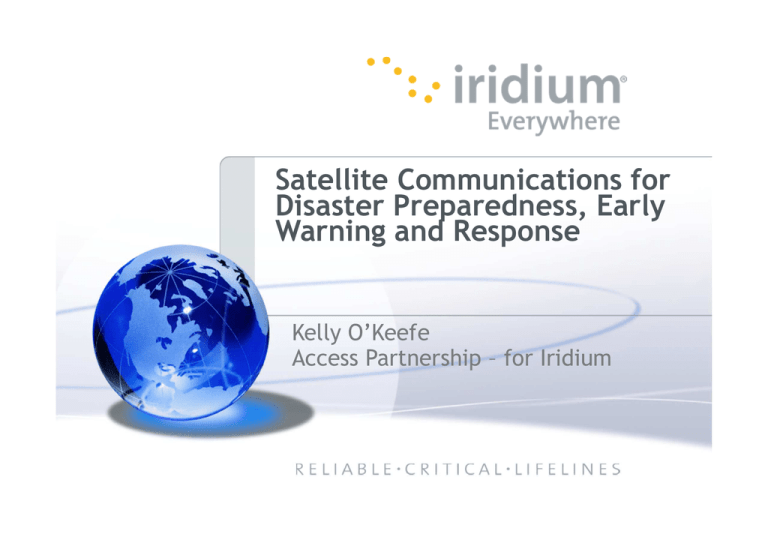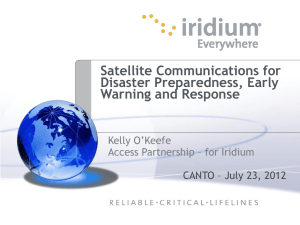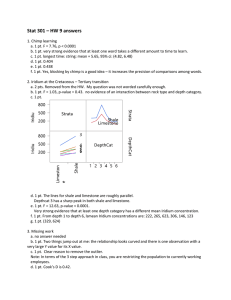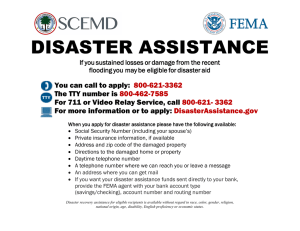Satellite Communications for Disaster Preparedness, Early Warning and Response Kelly O’Keefe
advertisement

Satellite Communications for Disaster Preparedness, Early Warning and Response Kelly O’Keefe Access Partnership – for Iridium Overview • Why Satellite ? • About Iridium • Lessons Learned • Multi-stakeholder Collaboration 2 Iridium Proprietary and Confidential 30/07/201 2 Sequence of Events Multiple solutions required due to shifting needs Disaster Preparedness Disaster Warning Rebuild Evacuation Disaster Strikes Cleanup First Responders Search & Rescue Reinforcements Arrive Disaster Assessment Satellite Communications are… • Highly survivable (physical survivability and robustness). • Independent of terrestrial infrastructure. • Able to provide load sharing and surge capacity solutions for larger sites. • Best for redundancy – then add a layer of path diversity and link availability. 4 Benefits of using satellite… • • • • • • Ubiquitous coverage Instant Infrastructure Independent of terrestrial infrastructure Temporary network solutions Rapid provisioning of services Capabilities: • Fixed-to-Fixed • Mobile-to-Mobile • Fixed-to-Mobile • Point-to-Multipoint 5 Solutions… Video/Data FSS: • Broadband Connectivity • Network Restoration • Communications on the Move Voice/Data MSS: • • • • • • • • • • Mobile Telephony Push-to-Talk Radio Emergency Response Coordination Dispatch Coordination Messaging Asset Tracking Data Transfer Lone Worker Protection Environmental Monitoring Event Reporting Iridium - Introduction • Iridium: a Satellite-based Personal Communication Services (SPCS) system • Operating since 1999, currently over 500,000 customers • Only communications network to cover 100% of the earth including the poles • Provides reliable communication links where landline or mobile phone connections are unavailable, unreliable or overburdened – including during disaster situations • Markets include emergency services, maritime, aviation,, oil and gas exploration, forestry, mining, journalism ... 7 Satellite Constellation Today • Unique fully-meshed network of 66 satellites with in orbit spares • Communication from anywhere to anywhere on the planet • Independent of terrestrial infrastructure • Cross-linked architecture provides redundancy and very high reliability 8 Summary of Today’s Network Intersatellite Crosslink Satellites Aircraft users Subscriber (Service) Links Feeder Links Handheld users Iridium Gateway Terrestrial Phone & Data Network 9 Maritime users Iridium NEXT – Next Generation • Bold vision for a second-generation satellite constellation • Anticipated to begin launching in 2015 – will maintain existing 66 satellite architecture • Expand and enhance Iridium's unique capabilities: more power, higher data speeds, IP technology, full backward compatibility • Expand services on land, at sea, and in the skies Global voice and data connectivity with increased speeds Machine-to-Machine (M2M) applications including asset tracking and remote monitoring • Unmatched coverage means access to remote and rural areas Networks delivers wireless broadband to hard-to-reach areas Supports services in developing countries 10 Iridium System - Devices Satellite Handheld Phone • Works anywhere in the world • Just like dialing a GSM phone Proprietary and Confidential Shipboard/Rig/Fixed Equipment • Easy to install • No moving parts • Supports prepaid calling Government • • • • • Environmental monitoring Pipeline monitoring Distress and alarm GPS compatible Asset tracking Iridium Disaster Communications Applications • Disaster Early Warning • Situational awareness • Damage assessment reporting • Managing deployed resources • Relief supply logistics support • Supply movement tracking and redirection • Coordination of search and rescue efforts • Injury/death reporting • Request for medical team support • Coordination of evacuations • Facilitating communications between first responders / relief workers and survivors and family members Introducing Iridium Extreme • Iridium’s latest mobile satellite handset Certified as the toughest MSS handset available GPS-enabled for location-based services Programmable SOS button Enhanced messaging features Open development platform for location-based services Launched September 2011 13 Iridium Proprietary and Confidential 30/07/201 2 Iridium Extreme – Location Based Services More than just a point on the map. Locating your critical human resources on a map is just the beginning 14 Iridium Proprietary and Confidential 30/07/201 2 Programmable SOS Button Emergencies can occur quickly So the Extreme was equipped with a single button that will send an email and make a phone call to a designated emergency response center. The SOS function is compliant with RTCM SEND specifications And, in the event of an emergency… 15 Iridium Proprietary and Confidential 30/07/201 2 Location Based Services +SOS The Iridium Extreme is a critical tool for managing deployed resources in a crisis An SOS is triggered by a user, Routed to emergency responders, Presented via web portal, Allowing for rapid evaluation and a coordinated response. 16 Iridium Proprietary and Confidential 30/07/201 2 SOS 1610z 57°09′09 ″N 2°06′36″ W Historical Usage of Iridium for Disaster Recovery • • • • • • • • • • Taiwan Earthquake (1999) South Pole rescue (2001) September 11 (2001) Asian Tsunami (2004) Hurricanes Katrina and Rita(2005) Pakistani Earthquake (2005) Hurricanes Gustav, Hanna and Ike (2008) Haiti and Chilean Earthquakes (2010) Gulf of Mexico Oil Spill (2010) Japanese Tsunami (2011) Disaster Communications – Lessons Learned Lessons learned from previous disasters has led to Iridium to take the following advance measures: • Maintaining stock of equipment for emergencies • Working with distribution partners to ensure supply chain continuity and facilitate rapid deployment • Equipping phones with solar panels for charging in situations where the electrical grid is damaged • Promoting pre-positioning of phones for preparedness • Test your satellite phone week Lessons Learned Governments should be prepared by: • Pre-positioning emergency equipment and solutions • Developing alerting and early warning systems • Training • Maintaining Equipment 19 Iridium Proprietary and Confidential 30/07/201 2 Iridium Global Disaster Communications Activities • ITU Cooperation Agreement – 66 satellite phones; deployed to disaster sites. • Leadership of ITU-D Rapporteur Group on Disaster Communications and participation in ITU-R and regional (CITEL) studies on disaster communications • Membership on FCC Communications Security, Reliability and Interoperability Council's (CSRIC) and State Department International Disaster Response Subcommittee of the Advisory Committee on International Communications and Information Policy (ACICIP) Proprietary and Confidential U.S. State Department Sub-Committee • Formed in 2010 following the response to the earthquake in Haiti • Reports to the Advisory Committee on International Communications and Information Policy in an advisory capacity regarding issues related to the information and communications technology (ICT) aspects of U.S. international disaster response. • Comprised of manufacturers, service providers, NGOs, trade associations – all involved in ICT aspects of disaster response • In November 2011, provided recommendations to the U.S. Government on actions to facilitate enhanced public and private sector international ICT responses 21 Iridium Proprietary and Confidential 30/07/201 2 Common Themes Identified • Information • • • • • What is the condition of the network? What critical infrastructure has been affected? What are the priorities for restoration? What resources or equipment is needed? What in-country expertise exists? • Contacts • In government agencies, affected countries, NGOs, private sector companies, service providers, suppliers, industry associations, etc. • Relationships • Collaboration 22 Iridium Proprietary and Confidential 30/07/201 2 Committee Recommendations Recommendations to Enhance ICT Aspects of U.S. International Disaster Response: 1. Foster Global Disaster Preparedness and help to reduce barriers often faced by private, public, and NGO ICT providers 2. Increase recognition of ICTs as critical infrastructure for international disaster preparedness and response 3. Improve coordination and expedite engagement between host country response leads and public, private and NGO ICT providers 4. Improve communication and information flows http://www.state.gov/e/eb/adcom/acicip/disasterresponse/index.htm 23 Iridium Proprietary and Confidential 30/07/201 2 ITU-D Question 22/2 2007-2010 Study cycle Three reports already published: • “Guidelines for Implementation of Satellite Telecommunications for Disaster Management in Developing Countries” (2009) • “Guidelines for using a content standard for alerts and notifications in disasters and emergency situations” (2008) regarding implementation of ITU-T Recommendation X.1303 on the Common Alerting Protocol (CAP) • “Report on use of remote sensing for disaster prediction, detection and mitigation” (2008) Question 22-1/2 2010-2014 Study Cycle • Examination of telecommunications/ICTs to assist countries in utilizing applications for preparedness and response • Best Practices/Guidelines on Implementation of ICTs for disaster prediction, response, relief and recovery • Consideration of regulatory/policy environment • Examination of the role that private sector and NGO’s have in addressing disaster management and the use of telecommunications/ICTs • Examination of how telecommunications/ICTs can be integrated into disaster management plans or frameworks, including considerations of telecommunications outside plant Cooperation and Collaboration • ITU-D Q-22-1/2 cooperates and collaborates with other entities to leverage existing technical resources and expertise and ongoing initiatives to benefit developing countries: • ITU-Radiocommunication Sector (ITU-R) • ITU-Standardization Sector (ITU-T) • Regional Organizations (APT, CITEL, ATU) • UN Organizations Expected Outputs • Case studies from member states and sector members • Best Practices/Guidelines on establishing National or Regional Disaster Communications Management Plans or Frameworks • Updated Handbook on Emergency Telecommunications and Online Toolkit with links to information resources and organizations • Handbook on Telecommunication outside plant in areas frequently exposed to natural disasters What you can do! • Participate in the next meeting of ITU-D SG 2: • September 17-21, 2012 • Submit contributions to the meeting: Case Studies, Descriptions of Technical Solutions, Information about National or Regional Disaster Communications Plans • Join the Correspondence Groups for the Handbooks (Emergency Telecom/Online Toolkit and Outside Plant) Questions? Thank you. 29





